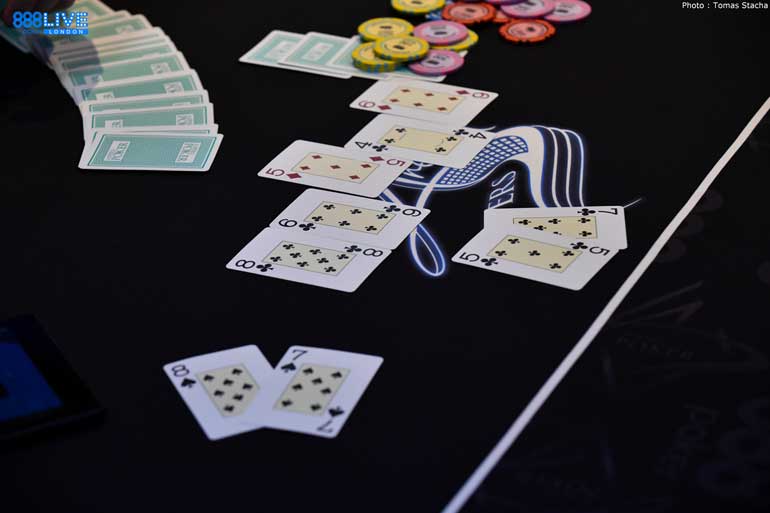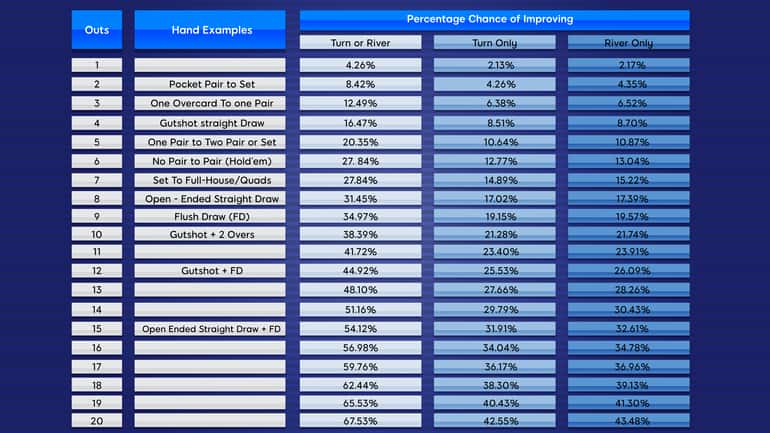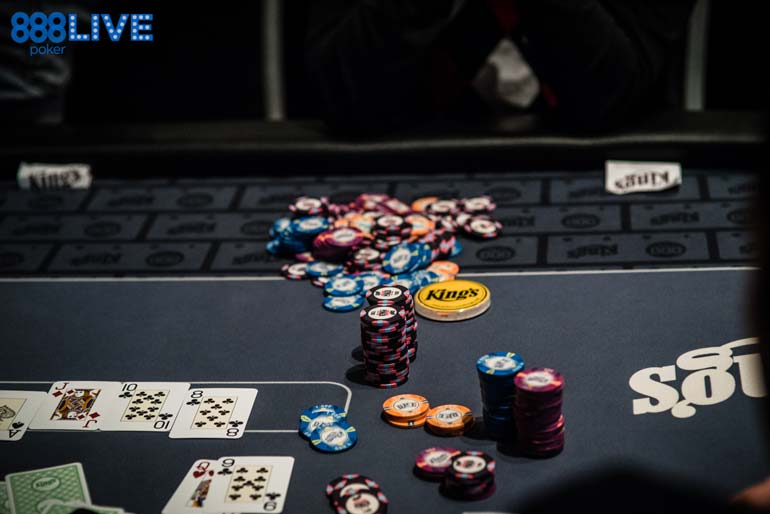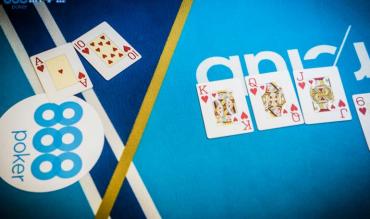In poker, draws are ever-present. Say you’re aiming to improve the strength of your hand or just discarding cards and taking new ones (another definition of the term).
You can’t get away from draws!
In this article, we’ll explain all the wraps on draws:
- What they mean
- How to play them
- What are some of the different variants in draw poker?
Table of Contents
The Definition of Draws in Poker
Draws can have a few different definitions in poker:
- Most commonly, a “draw” refers to a hand that has relatively weak showdown value at the moment (usually just a high card). But it can advance in strength dramatically when the right card comes. The most common draws will improve a player’s hand to a straight or a flush.
- “Draw” in poker can also refer to the act of discarding a select number of cards and replacing them with the same number of new cards. This act is often to improve the strength of one’s hand. This definition of “draw” will be used in the gameplay and the name of select variants like 5-Card Draw and 2-7 Triple Draw.
The Different Types of Straight and Flush Draws
 Different Types of Straight and Flush Draws
Different Types of Straight and Flush Draws
Not all draws are created equal.
Some draws are easier to hit, while others can only improve with a few select cards.
In addition, the value of the hand you’re drawing to can vary dramatically, too!
- Say you have 6-5, for example, on a board of 9-8-A. If a 7 comes, your opponent could improve to an even better straight with J-T or T-6.
- It’s the same scenario with flush draws. Say you have a baby flush draw and a 3-flush completing card hits. Well, your opponent could have an even better flush now!
That said, it’s still exhilarating to chase any sort of draw in poker.
So, let’s dive into expanding on some of the specific draw titles in the game:
- Inside Straight Draw: This straight draw contains only four outs. (An “out” is a card that can improve the strength of your hand.) If you have J-T and the board is 8-7-2, you have an inside straight draw. Any Nine will give you a 5-card straight.
In essence, this type of draw refers to needing any of the three inside straight cards to improve. Another name for this type of draw is a gutshot straight draw.
- Open-Ended Straight Draw: This draw covers the outside part of a straight. (It’s the opposite of the gutshot). In this case, you would have four consecutive cards currently.
You now need a top or bottom card to make 5-card straight - a total of eight outs. (An example would be having 9-8 on a 7-6-2 board. You could either hit a Five or a Ten to make your straight.)
- Double Belly Buster Straight Draw: This draw carries the same number of outs as an open-ended straight (8). It is a special type of inside straight draw that could improve to a 5-card straight in multiple places.
For example, if you have 9-8 on a board of 6-5-J-Q, you have a double belly buster straight draw! You can hit either a Seven or a Ten to complete a 5-card straight. So, you have two inside straight draws.
- Flush Draw: This draw leads to having five cards all in the same suit. Note that in poker, no suit is better than another. The only difference in the rank of flushes is the value of the cards that make up a flush.
For example, an Ace-high flush (the “nut” flush) would beat a King-high flush.
- Combo Draws: This scenario happens when you have more than one draw in the works. For example, say you have both a straight draw and a flush draw. You can have up to 15 outs in games like Hold’em to improve to a straight or a flush if you have a combo draw. (Sometimes even more outs if you’re playing Omaha).
Note that a “combo draw” is slightly different from a “straight flush draw.” In the latter, you are drawing specifically to a straight flush instead of a straight or a flush. Say you have A♣2♣ on a board of 3♣4♣8♠c – that’s a straight flush draw and not a combo draw).
- Backdoor Draws: These draws can come in if you hit two perfect cards on the turn AND river to improve your hand. Say you have A♣2♣ on 3♠4♣-8♠.
You currently have 3-to-a-flush or a backdoor flush draw.
You would have to hit clubs on both the turn AND river to make your flush.
- Wraps: Wrap draws are specific to games like Omaha. They occur when you have a straight draw with multiple hole cards connected/wrapped around the board.
For example, assume you have K-6-5-4 (hole cards) on A-7-3 (community cards). You must use two hole cards in combination with three of the community cards. So, you don’t have a straight yet. But your “wrap draw” gives you plenty of outs of improving to a straight: any 4, 5, or 6 would do the trick!
Poker Draws: Outs and Probabilities of Improving
As previously mentioned, an out is a card that can improve the strength of your hand. Most commonly, outs will relate to the following –
- Help calculate a player’s chances of improving
- And, subsequently, if they will have the right price to call, relative to the current pot odds
Are you looking to find your chances of hitting your draw based on the number of outs you have?
Check out our very own handy dandy outs and percentages chart.
 Outs and Probabilities of Improving
Outs and Probabilities of Improving
Here, you’ll see the percentages listed for your chances of improving both with one card to come (i.e., the river only or immediately on the turn). You’ll also find the odds for the turn OR river collectively.
| Once you know your chances of improving, it’s a good idea to look at the pot odds you’re getting to know how to proceed. |
- If you have the correct pot odds, then you can profitably call.
- If not, you should either fold your draw, raise (as a semi-bluff), or see if you have the right *implied* odds to continue.
Implied odds mean the possibility of winning additional money on future betting rounds to make up for not having the correct direct price to call currently.
Playing Flush Draws
Flush draws will very frequently contain nine clean outs to improve. But it can also be quite obvious when the flush completing card arrives on the board. So, it can be difficult to get paid.
- It’s better to play aggressively with your flush draws containing no showdown value (weak, high-card holdings that only have the flush draw).
- Play combo draws, Ace-high nut flush draws, or pair + flush draws much less aggressively.
Say you had the betting initiative before the river. It can be ok to continue bluffing some of your WORST missed flush draws (in case you brick out your draw on the river)
But do be aware that your flush draws should most commonly be “give-ups” on the river. Otherwise, you’ll typically be over-bluffing in these river spots.
For a detailed account of all the odds relating to flush draws, be sure to check out this guide on the topic.
Playing Straight Draws
It’s essential to realise that not all straight draws are created equal.
Stack sizes, position, and type of straight draw will all vastly affect how you ultimately want to play it.
Say, on the river, you’ve had the betting initiative in the hand. Missed straight draws are typically the best candidates to continue bluffing. You unblock the flush draws your opponent could have.
They would have often called the two streets of betting with nine outs and then passively fold river after missing.
For all the odds relating to straight draws, check out this in-depth article.
 Playing Straight Draws
Playing Straight Draws
Draw Poker: Variants of the Game
The two most common types of draw poker are 5-Card Draw and 2-7 Triple Draw.
5-Card Draw
In this game, all players receive five cards. The objective is to make the highest 5-card hand (according to standard poker rankings) through one drawing round.
- In terms of gameplay, after the first betting round, the remaining players select cards to discard, which they then replace.
- Players aim to improve their hand to an even better 5-card hand than their initial one. (Some versions use antes to start while others use blinds.)
- Generally, the maximum number of allowed cards to draw is three. But you can draw FOUR cards if an Ace is your 5th card.
You can also draw more than three cards in select versions of the game, like those played in casinos.
After the drawing round, a final round of betting takes place before reaching Showdown.
The player who shows the highest-ranking 5-card hand takes the pot.
2-7 Triple Draw
Like the previous form of draw poker above, each player receives five separate hole cards to start. This time, though, there are three rounds of drawing new cards.
- And a player’s objective is to make the LOWEST possible poker hand.
Note that Aces are always high in this game, and straights and flushes count AGAINST you having a low hand.
As such, the best possible hand is 7-5-4-3-2 (unsuited).
There are four betting rounds, each separated by three drawing rounds. Triple Draw is a limit game.
- For the first two betting rounds, the betting increment will always be the size of the small blind.
- For the subsequent final two betting rounds, the increment will be double the size of the small blind.
Each betting round has four as the maximum number of bets/raises, except for the first round. This round has three (initial raise, re-raise, one last raise).
After the final betting round, the remaining players show down their cards, and the lowest “high” hand wins.
FAQ: Frequently Asked Questions
Q: What does a draw mean in poker?
A: A draw in poker typically means that a player is looking to improve to a straight or flush. A draw can also refer to a game variant of poker where players discard/replace one or more cards during the “drawing rounds”.
Q: What is the difference between 7-Card Stud and Draw Poker?
A: In 7-Card Stud poker, players are individually dealt a total of seven cards over seven betting rounds (four face-up and three face-down). They must use these to make the best 5-card hand. In draw poker, players are always dealt only five cards and have drawing rounds where they can discard/replace their cards.
Q: How many times can you draw in poker?
A: It depends on the variant of the game you’re playing. In 5-Card Draw, there is only one drawing round. In Triple Draw, there are three drawing rounds, as the name suggests.
Q: What is a straight draw in poker?
A: A straight draw is where you have four of the five cards necessary to complete a consecutive sequence of cards. For example, 4-5-6-7 would be a straight draw and would graduate to a straight with either a 3 or an 8.
Q: What is a flush draw in poker?
A: A flush draw is where you have four cards of the same suit. Getting a 5th suited card of the same suit would give you a flush. (A flush is where ALL the cards in the 5-card poker hand are of the same suit).
The Bottom Line: Summary
This article should have shone some light on how to play the drawing hands in poker. Perhaps you’ve learned a new “draw poker” variant of the game.
But hopefully, you now have some solid insight and a good starting point on everything related to draws.
Until next time, good luck at the tables!


